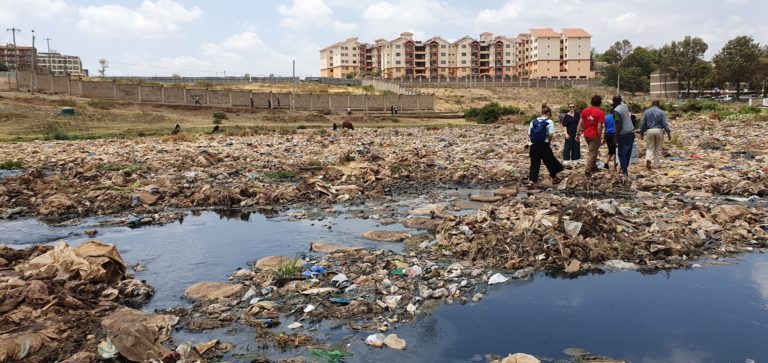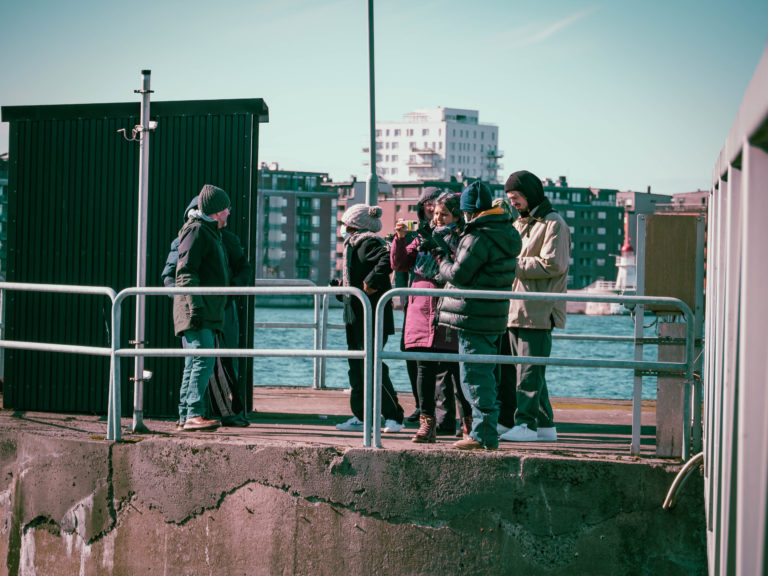This blog post is written by Alex Weisend, Alexia Moulin and Sara Saleh, students at the MSc course Act Local, Think Global.

Nairobi Dam. Photo: Emily Wade
What new perspectives on water access, use and design can be explored when collaborating with students from a country with vastly different challenges?
If there is an antithesis to a post-industrial harbour in a northern European, medium-sized town, it could, at first glance, be that of an overgrown dam in Nairobi, Kenya. It is in this economic, social, environmental, and not the least spatial contradiction that our team has approached the question of water access, use and design.

Visit in Nyhamnen, Malmö. Photo: Alexia Moulin
Nyhamnen is a constructed landfill, developed in order to expand in a growing, global industry. Nairobi dam of today reminds of a landfill, but is a consequence of political and economic circumstances with adverse environmental and social effects. Nyhamnen is an area that has been used to a limited extent by the city’s inhabitants, whilst Nairobi dam borders to, and is to a large extent integrated in, Kibera, the second largest informal settlement in Kenya. Although both sites face challenges of pollution, Nairobi dam is subject to an accumulation of urban runoff, inadequate sewage systems and the outcomes of poor sanitation facilities carried by rivers and tributaries with a final outlet in the dam. Nyhamnen is subject to a preceding industrial pollution, and in periods of extensive rainfall, to urban runoff.
Working together with students from Nairobi has – this far – had several effects on our design thinking. Seeing the possibilities of “our” site through the eyes of the Nairobi students – and specifically through their design analyses and concepts, has challenged us in our interpretation of the site. Mitigating rising sea levels by sculpting the land into dramatic hills and valleys, as suggested by one Kenyan student, inspired us to explore unconventional design solutions. It also emphasized the urgency of the global climatic conditions and how these require critical measures. We are not only theoretically aware of this. Being prompted by students with a first-hand experience of the consequences of climate change as well as of political and economic conditions in interplay with these, reinforces our incentive to practicing it.
Nairobi dam has been subject to a range of programs and measures taken to improve the conditions of the reservoir. The obstacles that have hindered a long term and extensive development of the past waterscape are described in literature on the development of the Nairobi dam, that we have taken part of. Despite the difference in severity and scale between Nyhamnen and Nairobi dam, there are lessons to be learnt in implementing improvement measures in the case of the urban transformation of Nyhamnen too. In terms of water access, use and design, one of the obstacles of the Nairobi dam experience has been that the extent of the defined extent of the project and the site has been too small-scale. Without engaging the local community, taking into consideration climate change, pollutants along the watercourse and economic circumstances affecting the use and misuse of the water, programs for treating the water risk being carried out in vain. The fluid character of water imposes on us a global perspective, in Nairobi dam as well as in Nyhamnen.
Act local, think global is as much the name of this class and a subtheme in the IFLA of 2023 as it is a method for learning from dramatically contrasting circumstances and applying them to our local conditions. An antithesis can also be a design tool that reveals a global parallel.
This blog post is the second one in a series of four blog posts from the Master’s course Act Local, Think Global given by SLU and JKUAT Nairobi.
